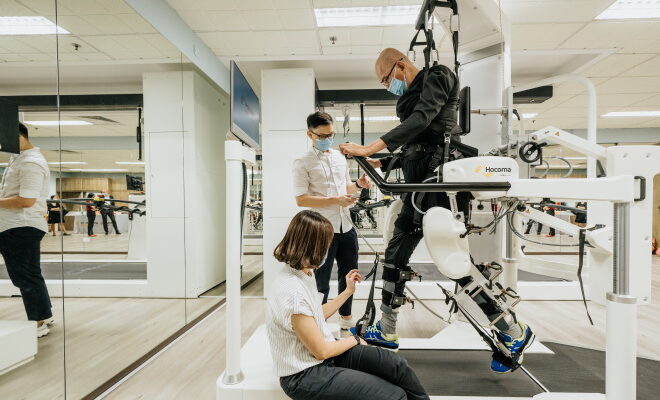
The Gen XY Lifestyle
First Holistic Robotics Rehabilitation Centre Opens in Singapore
Singapore Robotics Rehabilitation Centre and DIH Asia Pacific Hub, a global distributor of rehabilitation technology, has opened the first holistic robotics rehabilitation centre in Singapore.
The Singapore Robotics Rehabilitation Centre is staffed by highly trained therapists. Through their treatment work, they aim to help restore function in patients suffering from “…troke, trauma, reparable spinal injuries, hip replacement, chronic pain, and many other physically debilitating conditions.”
They will do so through the design and use of interdisciplinary, patient-focused treatments that will help patients regain a better quality of life.
The facility is strategically located on Orchard Road and will feature the Lokomat®Nanos by Hocoma and the C-Mill VR+ with Hero Solution by Motek. The Hocoma’s Lokomat® is a leading robotic medical device for gait rehabilitation and the C-Mill VR+ by Motek is a treadmill trainer integrated with augmented and virtual reality.
The Singapore Robotics Rehabilitation Centre shared about their perspective on using robotics assistance and VR in rehabilitation with the Active Age.
the Active Age (AA): What’s the perspective behind using both robots and VR for treatment and rehabilitation?
The Singapore Robotics Rehabilitation Centre (SRRC): Using robots and VR addresses the 5 main components of motor re-learning principles, which traditional therapy cannot always adhere to or address all the time.
These are to “start as early as possible”. These devices allows early mobilisation and therapy once patient is medically fit and stable. The training needs to be specific and functional. For example, the lokomat provides physiological gait pattern, which allows the patients to learn the proper movement pattern. It has to be high intensity. Robotics and VR provide patients the opportunity to do a higher number of repetitions. There has to be provision of proper feedback. The devices provide real time and detailed afferent feedback to patients which is important for neuroplasticity. The therapy needs to be motivating and engaging. The training and therapy programs in the lokomat and Hero solutions provide simulating games that challenges patients in optimal manner.
AA: How does the brain adapt and react to treatment using robots and/or VR?
SRRC: It helps with neuroplasticity, where the brain has the ability to re-learn, and by providing a motivating environment for the learning. Neuroplasticity is the brain’s ability to reorganise itself by forming new neural connections throughout life. Neuroplasticity allows the neurons (nerve cells) in the brain to compensate for injury and disease and to adjust their activities in response to new situations or to changes in their environment.
AA: What is the context and the foundation to understand this format of treatment compared to other traditional methods?
SRRC: The use of robotics and VR promotes higher intensity for rehabilitation as compared to other traditional methods. For example, traditional therapy allows 300 steps versus robotic therapy allows at least 2000 steps per therapy session.
Furthermore, using robotics and VR helps to provide external cues for implicit learning and stimulate daily living activities.
The use of technology also caters to address the cost of manpower in delivering consistent and effective therapy to every single patient. For example, if a therapist sees 10 patients a day, he or she will be tired by the time the eight or ninth or tenth patient comes for therapy. Hence, there might be inconsistency of care and delivery of therapy. But if robotics were used, it delivers consistent therapy to every single patient without prejudice.
The use of technology gives dignity not only to patients (where patients feel empowered by being independent and in control of their therapy) but also therapists because it allows them to focus on clinical evaluation, releasing them from performing manual tasks like supporting the patient.
AA: How did Lokomat® therapy come about, and what does it consist of?
SRRC: It was created more than 20 years ago when the Swiss founders developed the lokomat for treating spinal cord injuries in an efficient and effective way. It consists of robotic orthosis, with dynamic body weight support and the proprietary software for training neuroplasticity.
AA: Are there challenges in training physicians and therapists to use the HERO solution?
SRRC: The lack of awareness and education on the use of technology for rehabilitation could be a challenge. Also, the attitudes of therapists and physicians to accept technology.
AA: What is the future of rehabilitation when it comes to combining robots and VR?
SRRC: There is big potential. Firstly, it address manpower needs and costs. Secondly, robotic assisted therapy is strongly evidenced based. Thirdly, patients are also more educated and becoming more aware of this technology and they want to try. By providing this devices at the Singapore Robotics Rehabilitation Centre, patients can have more access to such treatment.
Images and videos provided by Singapore Robotics Rehabilitation Centre.






